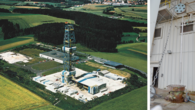What are gas hydrates?
Gas hydrates are ice-like solids composed of water and gas molecules, whereby water molecules build a three-dimensional network of water cavities encasing gas molecules. The (nonpolar) gas molecules in turn prevent the water cages from collapsing. Gas hydrates form at elevated pressure and low temperature and in presence of sufficient amounts of gas and water. These conditions are present at the seafloor, in permafrost regions and deep lakes. Gas hydrates therefore occur worldwide – in oceanic sediments on the continental slopes at all active and passive continental margins and permafrost areas.
Natural gas hydrates
Natural gas hydrates contain predominantly methane and lighter hydrocarbon as well as CO2 or H2S. The trapped methane can be of both microbial and thermogenic origin. Depending on the source of the feed gas the amount of additional gases besides methane varies from less than 1 mol% to more than 40 mol%. The thermodynamic properties of the resulting hydrate phase, such as the stability field or the enthalpy of, depend strongly on the hydrate composition. Mixed gas hydrates containing H2S, CO2 or higher hydrocarbons such as C3H8 in addition to CH4, show a larger stability field compared to simple CH4 hydrates: The stability limits shift to higher temperatures and lower pressures.
Enormous amounts of gas can be stored in gas hydrate deposits: 1 m3 gas hydrate releases approximately 164 m3 gas at standard pressure and temperature conditions. 1-3% of gas hydrate deposits are believed to occur onshore, while 97-99% of natural gas hydrates have been found offshore. The global estimates of hydrate-bound hydrocarbons in marine and terrestrial sediments are highly speculative and ranged in the past between less than 1 x 1015 m3 to more than 1.5 x 1016 m3.
These variations in the calculation results are due to the different assumptions regarding the composition of natural gas hydrates and thus the stability conditions of the resulting hydrate phase as well as the hydrate saturation and morphology in the host sediment (disseminated versus massive layers). However, due to the significant amounts of methane suspected in hydrate-bearing sediments natural gas hydrate deposits are considered as a potential energy resource.

At GFZ the gas hydrate researchstarted in 2001. Scientists from GFZ were involved in the Mallik 2002 gas hydrate production research well program, Mackenzie Delta, Northwest Territories, Canada, where a first field trail using thermal stimulation for the production of methane from the hydrate-bearing layers were conducted.
Since then, our interests have focused on fundamental and applied gas hydrate research. Under laboratory conditions, we investigate the thermodynamic and physical properties of natural and synthetic gas hydrate samples with respect to composition and structure, phase behavior, enthalpy of dissociation, and formation and dissociation processes and kinetics. For our investigations we use Raman spectroscopy, X-ray diffraction, SEM and calorimetry. The experimental conditions are close to natural conditions and therefore serve as a basis for understanding the behavior of natural gas hydrates and for developing innovative methods for the recovery of methane gas from hydrate-bearing sediments.
The latter is a more applied aspect of our research. For this purpose, we have developed our large-scale reservoir simulator LARS with a total volume of 425 l (sample volume 210 l). LARS is equipped with temperature and pressure sensors and an electrical resistance tomography. In LARS, we have tested depressurization, thermal stimulation by in situ combustion of methane in a catalytic countercurrent heat exchange reactor, and injection of hot CO2 and a CO2-N2 gas mixture. another important aspect of our application-related research is the determination of geo-mechanical properties of hydrate-bearing sediments as a function of hydrate and/or ice content. For this purpose, we have developed a ring-shear-apparatus (ESTER), with which we can determine the shear strength of hydrate-bearing sediments.
Associated literature:
- Book: Gashydrate – Eine Einführung in Grundlagenforschung und Anwendung (Judith M. Schicks, in German only)
- ChemTexts (PDF): Gas hydrates in nature and in the laboratory: necessary requirements for formation and properties of the resulting hydrate phase (Judith M. Schicks)
Associated & closed projects:


![[Translate to English:] Gashydratknöllchen](/fileadmin/_processed_/0/e/csm_Schicks_Abb_4Hydratknoellchen_dbf687d455.jpeg)
![[Translate to English:] Gashydratvorkommen](/fileadmin/_processed_/d/c/csm_Abb_Gashydratvorkommen_0ed2f7c4f9.png)
